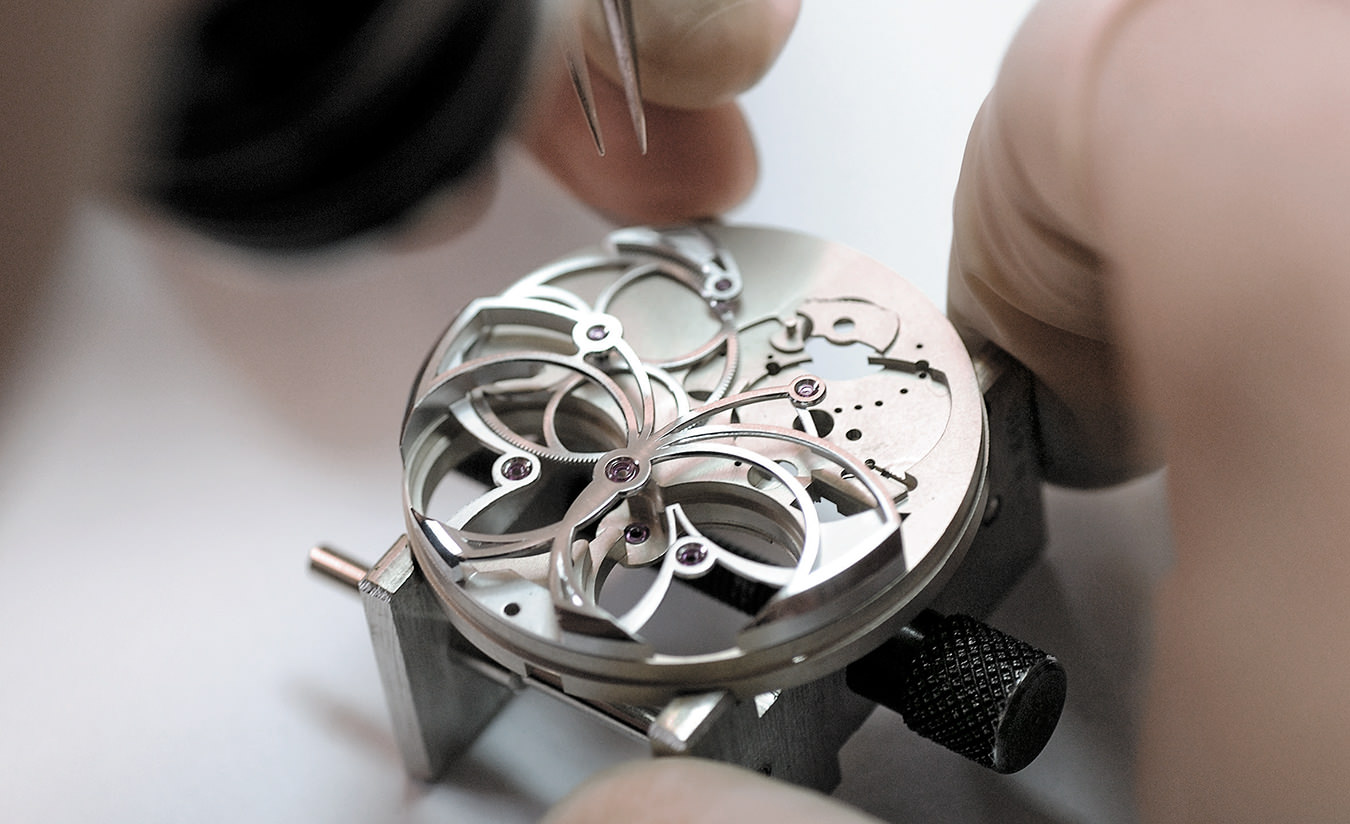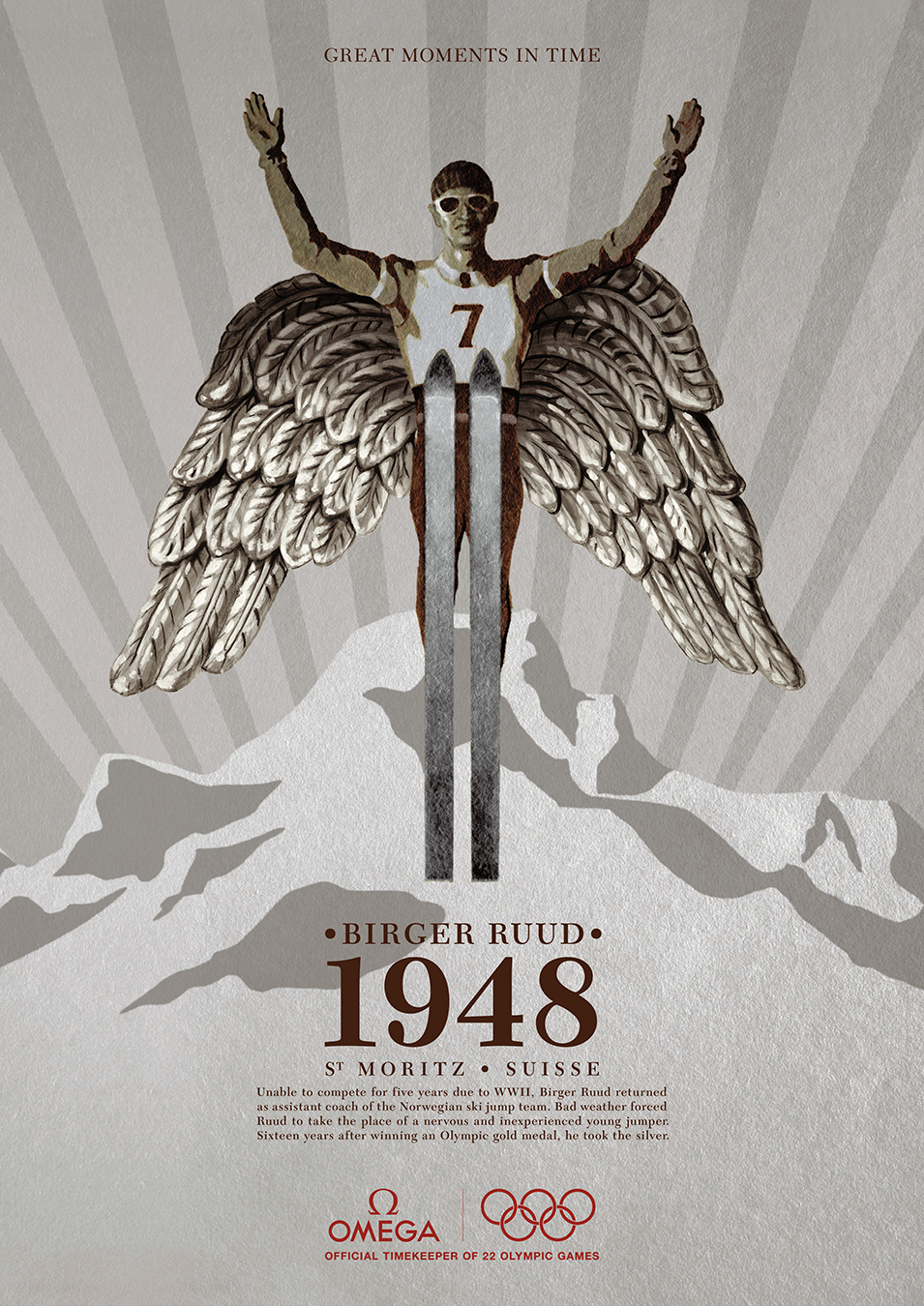This Remote German Town is Renowned for Watchmaking
Glashütte still ticking.
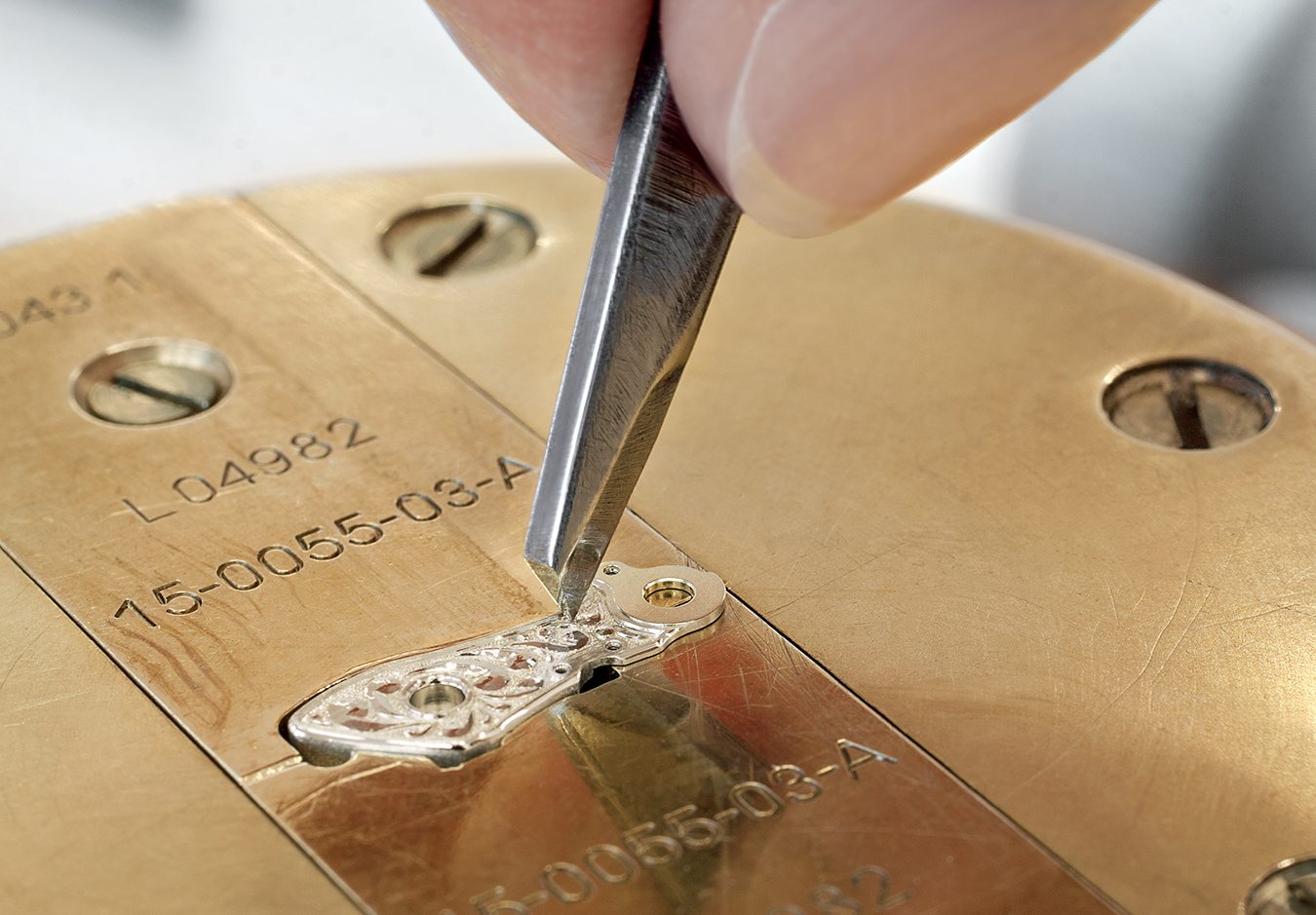
As 2013 drew to a close, an extraordinary timepiece began to tour the world, shown only to a few watch collectors. But among those individuals, even fewer could hope to own one, as only six pieces will be made.
The watch in question is A. Lange & Söhne’s Grand Complication. Not so much a watch as a masterpiece of horology, it incorporates the most sophisticated version of each of the three most technically challenging complications in traditional watchmaking. Instead of a regular chronograph, there is a split-seconds chronograph, but it’s a monopusher split-seconds chronograph accurate to one-fifth of a second interval; the perpetual calendar is combined with a moon-phase display, advances all of the indicators (except the moon phase) instantaneously at midnight, and will need no adjustment until the year 2100; and rather than a simple minute repeater, the Grand Complication has both a grande and a petite sonnerie. At this time, only one watchmaker is sufficiently skilled to assemble the timepiece (another watchmaker is being trained in the process), and each watch will take him a full year.
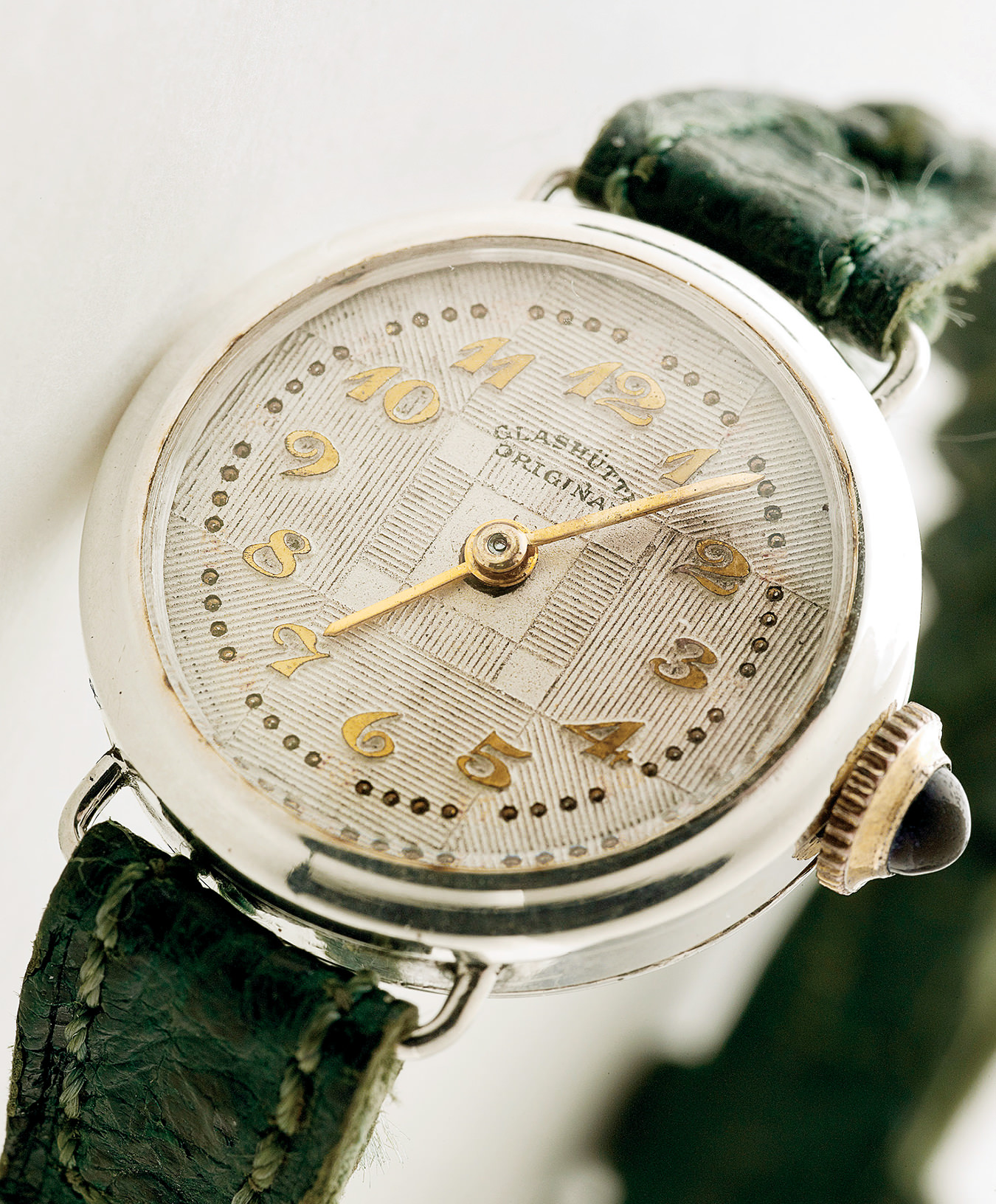
If proof were needed that German watchmaking is back at the height of its powers and able to compete with the finest work of its Swiss counterparts (as it was a century ago), the Grand Complication is it. When Anthony de Haas, Lange’s director of product development, says that it “represents a coming of age … a new era for Lange,” he is not exaggerating.
It could be argued, though, that the new age really began two decades ago. In 1994, having battled through the years of economic chaos that followed the fall of the Berlin Wall, three once-great German names re-emerged: Glashütte Original, Mühle-Glashütte, and A. Lange & Söhne. What all three have in common is that both their historic roots and their present-day headquarters are in Glashütte, a small town near the Czech border that, for all intents and purposes, defines German watchmaking.
To understand the significance of this, we must consider the tumultuous history of the past 170 years, when wars, financial crises, political dislocation, occupation, and socialism swept through Europe, changing the political, economic, and social landscape again and again. Glashütte was spared none of it. Its story, and thus the story of German watchmaking, is a paradigm of the history of Europe.
As you drive south from the city of Dresden, rolling green fields gradually give way to forested hills and a labyrinth of rivers and rocky gorges. Glashütte is tucked between the hills at the junction of two river valleys. For almost four centuries, the town profited from the deposits of silver in the surrounding Erzgebirge (Ore Mountains). However, as the mines became exhausted in the early 19th century, Glashütte fell on desperately hard times and eventually petitioned the Saxon court for help.
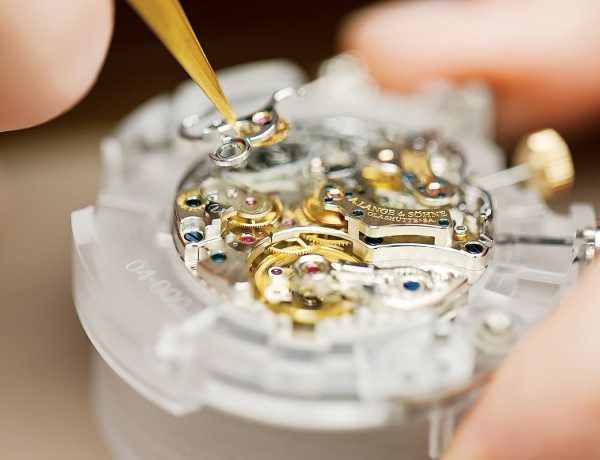
Assembly of a chronograph movement component at the A. Lange & Söhne workshop. Photo provided by A. Lange & Söhne.
Ferdinand Adolph Lange, a gifted young watchmaker with connections at court (his father-in-law was royal clockmaker Johann Christian Friedrich Gutkaes), suggested that watchmaking would be an ideal business to establish in the town. In 1845, armed with a government start-up loan and a grant to finance machinery, Lange set up shop in Glashütte and began to train local tradesmen.
The character of Glashütte’s pocket watches was quickly defined: they were to be straightforward but technically complete, with an emphasis on precision. To increase the stability of the movement, F. A. Lange developed the three-quarter plate, rather than employing Swiss-style individual bridges. It was cut away to reveal the balance wheel assembly, making it easier for servicing (and, with today’s sapphire-crystal case backs, enabling the owner to take pleasure from the kinetic sculpture). Over time, other characteristics became standard: screwed gold chatons for the jewels, a hand-engraved balance cock, a swan’s neck fine-adjustment lever, and Glashütte ribbing, a variant of the Swiss Côtes de Genève. The Glashütte watchmakers also favoured German silver, an alloy of copper, zinc, and nickel discovered by the German chemist E. A. Geitner in the early 19th century.
Lange’s pocket watches quickly found success, and within a decade, the business had spawned about 100 jobs. Lange had always intended that some of those he taught would start their own firms, making and supplying components to other watchmakers, thus creating a complete industry in Glashütte. This “workshop system” attracted specialists in associated fields, among them Robert Mühle, who founded Mühle-Glashütte in 1869. A precision-instrument maker, he created metric-measurement tools that superseded the traditional Parisian system of lignes (lines). Success bred success, attracting other watchmakers, such as Julius Assmann, Adolf Schneider, and Carl Moritz Grossmann (who founded the German School of Watchmaking Glashütte in 1878).
The establishment of the German Empire in 1871 and an increasingly affluent and cosmopolitan population resulted in the golden years for Glashütte. Its superb pocket watches were in demand all over Europe and prized not only for their technical excellence but also for their beautiful decoration, featuring enamelwork, engraving, and gem setting.
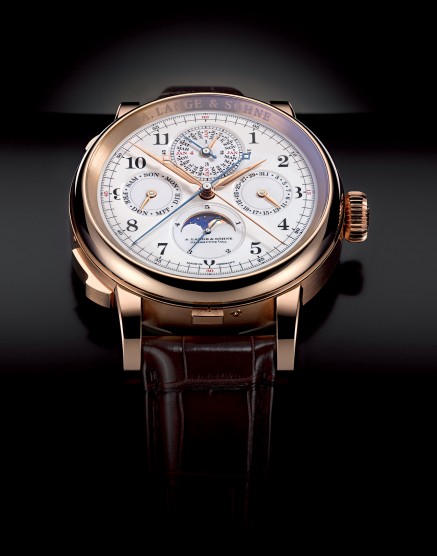
A. Lange & Söhne’s Grand Complication watch, of which only six pieces will ever be created. Photo provided by A. Lange & Söhne.
The First World War marked the beginning of the end. The war meant a drop in demand for luxurious timepieces, and it generated interest in a practical, modern invention: the wristwatch. The exquisite handmade pocket watches produced by Lange and its peers seemed irrelevant. There were glimmers of light in 1920 when Alfred Helwig, a renowned teacher at Glashütte’s watchmaking school, invented the flying tourbillon, and in 1927 when a ladies’ watch became the first timepiece to bear the brand name Glashütte Original. Glashütte watchmaking, however, as it had been known, was done in.
During the Second World War, the few watchmakers not drafted into the armed forces had to work for the war effort: A. Lange & Söhne was assigned to make B-Uhren, which were navigation watches for the Luftwaffe (now prized by collectors), while others made aircraft instruments and fuse timers for bombs. Walter Lange, the great-grandson of F. A. Lange and a budding watchmaker, was drafted as a teenager in 1942. Wounded twice, he finally arrived back home to Glashütte on May 7, 1945. Early the following morning, bombs rained down on Glashütte. A. Lange & Söhne’s main production building took a direct hit and burned. A few hours later, the war was officially declared over.
Glashütte slowly began to rebuild. The German School of Watchmaking Glashütte reopened, and the Lange family returned to work, making watches from spare parts found in the West. With their facility destroyed, they worked from the family residence, doubling as the company’s headquarters; the main production building was eventually rebuilt and inaugurated in 1947. A. Lange & Söhne was no worse off than other companies, all of which had their equipment seized by the Russian occupying forces and shipped to Moscow as war reparations.
The remote little town of Glashütte has succeeded not once but twice in creating a watchmaking business that can rival the world’s best—the town’s watchmaking future is assured.
Then, in 1948, came another blow: the new regime began to expropriate all businesses, land, and even intellectual property. In 1951, A. Lange & Söhne and six other watch manufacturers were amalgamated into VEB Glashütter Uhrenbetriebe (GUB), a state-owned conglomerate. Moreover, the pressure to join the Free German Trade Union Federation, a union that was controlled by the Socialist Unity Party, was even greater than it had been to join the Nazi Party. Under that threat, Walter Lange fled to the West and eventually settled in Pforzheim, resigned to making what he describes today as “ordinary watches … nothing like the work we did in Glashütte.” During the next four decades, Glashütte’s watches went decidedly down-market and, although reliable, they bore no other trace of Glashütte’s fine heritage.
But in November 1989, the seemingly miraculous happened: the Berlin Wall was breached, spelling the end of the German Democratic Republic. Walter Lange remembers, “It was almost unbelievable. For all of those years, I had never imagined that reunification would be possible. I couldn’t afford to dream—I simply had to earn a living.”
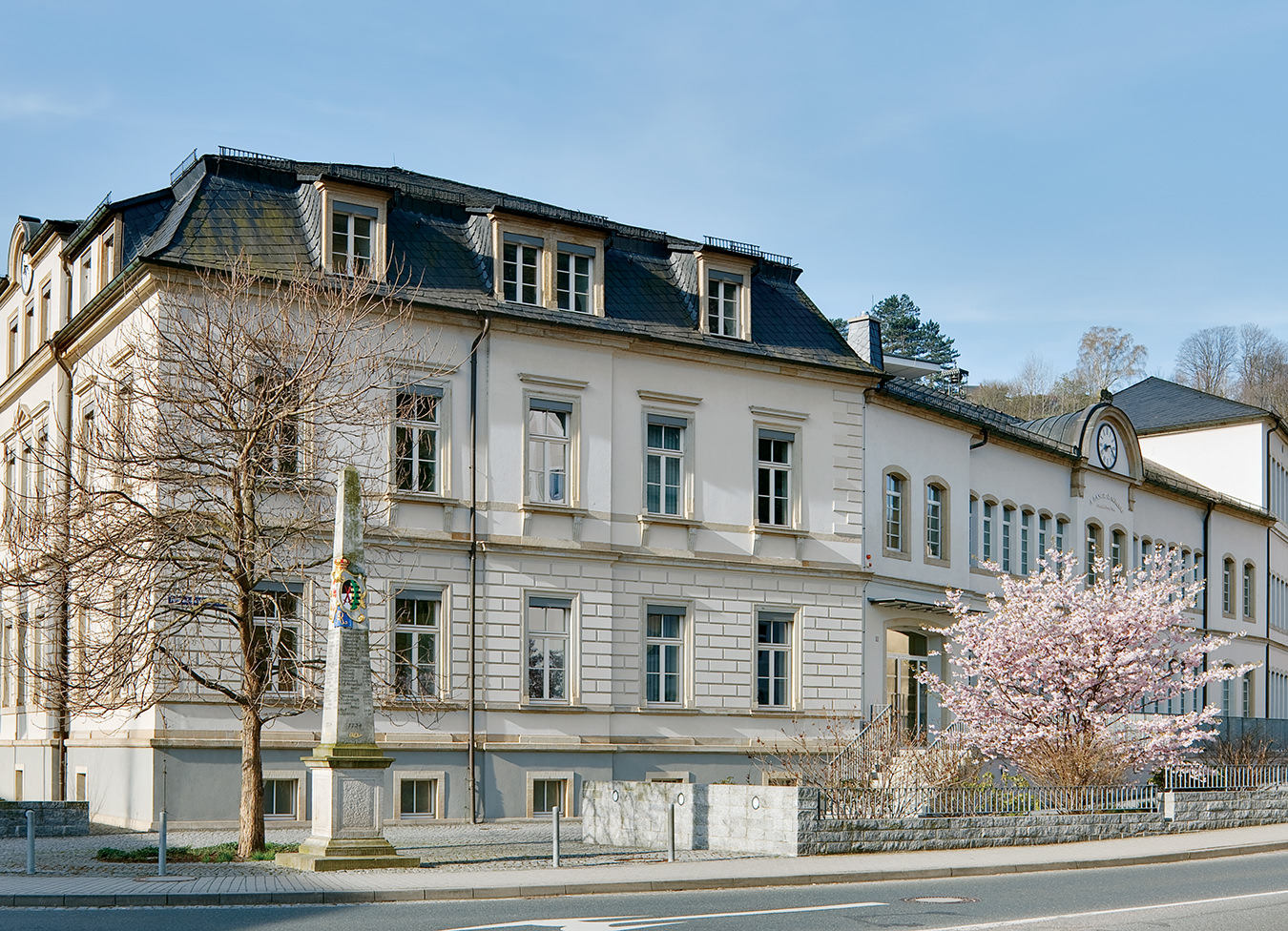
The original Lange family residence was built in 1873 and reopened as the company headquarters in 2001. Photo provided by A. Lange & Söhne.
Three months after the Wall fell, Roland Schwertner arrived in Glashütte. Soon after, he and three watchmaking colleagues decided to start a new business. With currency reform and reunification still months away, it was truly the “wild East”, but Schwertner and his partners registered the name Nomos Glashütte and began making watches from a dilapidated three-room apartment. In 1992, Nomos launched its first watch, the Tangente, followed soon after by three other models, and established legal protection for the Glashütte designation of origin. For a watch to qualify, at least 50 per cent of the movement’s value must be produced in the town.
Today, Nomos manufactures all of its own calibres from scratch, and with its good-looking, well-made watches, it has found a sweet spot. When Schwertner and his friends brought their swashbuckling entrepreneurial energy to Glashütte, Walter Lange had just retired in Pforzheim. Having returned to the East several times, Lange had, on one occasion, smuggled priceless documents about A. Lange & Söhne and technical details of its historic watches back to the West. Now, he began to dream. “To me, Lange without Glashütte and Glashütte without Lange was unthinkable. But when reunification came, my first thought was, what if we restart? Should we? Could we?”
Günter Blümlein, the visionary head of Les Manufactures Horlogères (the parent company of Jaeger-LeCoultre and IWC), was thinking the same thing. A native of Nuremberg, he knew that the German watchmaking tradition lay in Glashütte and had begun discussions with GUB in 1989. He also knew that A. Lange & Söhne defined Glashütte, and on hearing that “somebody Lange” was still alive, he arranged an introduction.
It was a meeting of like minds, but reviving the business would prove immensely challenging. Although the name A. Lange & Söhne remained, there were no watch designs, no watch movements or parts, no machinery, no premises, and not a single employee—let alone one with the skill to make fine watches. Instead of being welcomed to Glashütte, Lange and Blümlein encountered great mistrust (a result of the paranoid culture following reunification), as would-be employees insisted on meeting in secret for fear of ostracism by their neighbours.
Lange and Blümlein knew that if they were going to relaunch A. Lange & Söhne, it would not be enough to produce watches of exemplary quality; they needed to embody key elements that defined the Glashütte tradition. In October 1994, the renewed A. Lange & Söhne presented four new models. It was a home run: the aesthetically surprising Lange 1 has become the face of the modern brand, with its off-centre display and innovative outsized date display (never seen before in a wristwatch, it has been much copied since), while the Tourbillon Pour le Mérite claimed the technical high ground. A regular one-minute tourbillon would be too ordinary, Lange and Blümlein decided, so this timepiece combined it with a second type of regulator, the almost-forgotten fusee-and-chain mechanism.
GUB had been privatized in the years following the fall of the Wall. Recognizing its potential to become an autonomous manufacturer, a Bavarian businessman named Heinz Pfeifer bought GUB, relaunching the Glashütte Original brand in 1994 and, in 1996, spinning off Union Glashütte (originally founded in 1893 by Johannes Dürrstein). The former was pitched to the high end of the market, while the latter produces more affordable watches. In 2000, both companies were bought by Swatch Group.
In 2002, foreseeing a shortage of skilled craftspeople, Swatch Group opened a watch school in Glashütte called the Alfred Helwig School of Watchmaking (the original German School of Watchmaking Glashütte had closed in 1992); last year, the school doubled its capacity, taking in 24 new watchmaking apprentices. Swatch Group’s commitment to Glashütte was further underlined by its financing, through the Nicolas G. Hayek Foundation, of the excellent German Watch Museum Glashütte, which shares the school’s building. In 2003, the renovation of the old GUB building was completed, its light-filled workshops now arranged around a soaring atrium.
Standards at Glashütte Original have been moved consistently upward, and its collection today ranges from the appealing Sixties and Seventies collections, tapping into design nostalgia while providing great value for money, to complication watches that harness the best of Glashütte tradition and sit comfortably alongside pieces from Swatch Group’s prestigious Blancpain and Jaquet Droz brands. Signature models include the Senator Chronometer Regulator and Observer models and the PanoGraph flyback chronograph. The brand’s most complicated model to date is the Grande Cosmopolite Tourbillon, a magnificent 37-hour world timer with perpetual calendar and flying tourbillon.
With Glashütte’s watchmaking future assured, more watch companies have returned to the town, among them Tutima. Renowned as a maker of military pilot’s watches during the 1940s, the moribund brand name was bought by Dieter Delecate in the 1960s and since 1985 has made the official watch of the German Air Force, the Tutima Military Chronograph 798. More recently, watchmaker Rolf Lang and a team of colleagues developed the Tutima Hommage to mark the brand’s return to Glashütte in 2011. It was the first wristwatch minute repeater to be made entirely in Germany.
The newest kid on the high-end German watchmaking block, Moritz Grossmann brings the story of Glashütte full circle. Founded by watchmaker Christine Hutter, it pays homage to one of the greatest names of the past. And with partial financing through a grant from Saxony’s state government, it mirrors the very beginning of the business, when Ferdinand Adolph Lange received seed capital from a much earlier government. As Prime Minister of Saxony Stanislaw Tillich so eloquently understated when he cut the ribbon at the new manufactory this summer, “These public-private partnerships have always been a win-win situation for Saxony.”
The remote little town of Glashütte has succeeded not once but twice in creating a watchmaking business that can rival the world’s best. And as the people at Nomos are known to have said, it takes the kind of patient, stubborn, introverted perfectionists that you find in Glashütte to do it.
_________
Never miss a story. Sign up for NUVO’s weekly newsletter, here.

